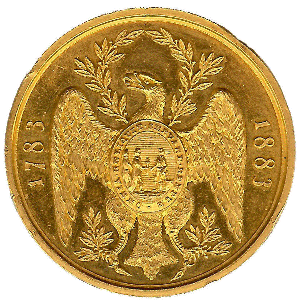The first medal (Hume #2) struck by the Society of the Cincinnati was
commemorative of its hundredth birthday. The Triennial General Meeting of
1881 adopted the following resolution:
"Resolved, That the committee be authorized to cause to be prepared a
commemorative medal, with appropriate design and inscription, to celebrate
the occasion of the Centennial anniversary of the foundation of the Society,
and that the several State Societies be requested, at their next annual
meeting, to determine the number of medals which each Society shall desire
for the use of its members, not in excess of the number of its members, the
same to be supplied at the expense of the said Societies."
The medals were authorized to be struck in bronze, silver and gold, and were
sold, under the terms of the resolution, to members. At that time there
were only about four hundred members of the Cincinnati, and as the medals
were only presented to the members who had subscribed for them, the
Centennial Medal is rare. Only two examples of the gold medal (below) are known to exist.



Centennial Medal (Obverse).
Hume #2.



Centennial Medal (Reverse).
This gold medal,
one of only two known extant, is inscribed to Hamilton Fish.
Hume #2.
34mm. Three medals: Bronze, Silver and Gold.
Each disc measures 1-3/8 inches in diameter, and 1/8 inch in thickness.
The obverse shows the Eagle of the Cincinnati, with the date 1783 at the left
and the date 1883 at the right. The reverse bears a wreath composed of a branch
of laurel leaves (left) and a branch of oak leaves (right), and above, at the
outer border, the legend: Society of the Cincinnati, and below, Inst. A. D. 1783. The center of the reverse contains space for the name of the member and of his
Revolutionary
propositus.
The medals were struck under the direction of Brigadier General Francis Winthrop
Palfrey, Secretary of the Massachusetts Cincinnati, and records show that
the dies and several of the bronze and silver medals were turned over to the
General Society from his estate after his death.
The price of the medal was fixed
at twenty dollar for gold copies, two dollars for the silver, and one dollar and
thirty cents for the bronze. On July 4, 1882, the Massachusetts Society of the
Cincinnati voted that one copy in bronze be presented to each member of the
Massachusetts Society at the expense of the Society, and that any member
"desiring to have his medal struck in gold or in silver could have it so on
notifying the Secretary of the Society and paying the difference in cost."
Hume's original publication, and that published in The Numismatist, included an image of
one of the bronze medals, without the name of the member and his ancestor
engraved in the space provided. While Hume wrote that there was no record that
any copies were struck in gold, one has since surfaced with the inscription:
Hamilton Fish New York Admitted July 4th 1834, shown above.
Last Page | Next Page | Return to First Page
All Rights Reserved.
Legal & Privacy Notices
